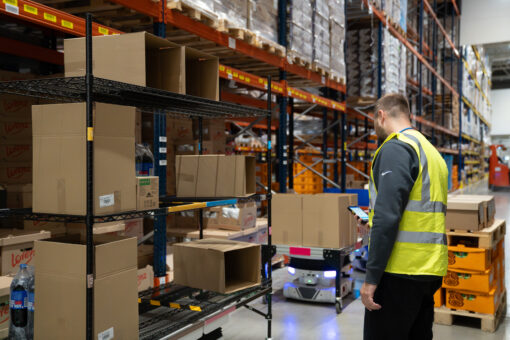WP: How to achieve 400 UPH with Locus Fast Pick
WP: How to achieve 400 UPH with Locus Fast Pick Download Now!
How to Apply AI in Your Warehouse: A Practical Playbook for Real Results
Mary Hart, Sr. Content Marketing Manager

For all the headlines about artificial intelligence (AI) changing warehouses, the reality on the ground is more nuanced, with many leaders asking the same questions: Where does AI actually help? How do we separate the hype from real ROI? And what can we do today that sets us up for tomorrow?
That’s why I sat down with Oscar Mendez, Head of AI and Data Science at Locus Robotics, on the Warehouse Automation Matters podcast. Our conversation focused not on future promises, but actionable ways to make AI work right now, which resulted in this playbook based on that discussion.
Start with the Business Value of AI in the Warehouse
Mendez made it clear that AI should be framed around business impact, not just clever capabilities.
“You’re not just asking, 'does the robot do the thing?'” he said. “You’re asking, 'does the thing make sense for the business?'"
That shift in mindset drives everything at Locus, where AI exists to improve throughput, reduce walking, optimize labor, and increase safety.
Your Move:
- Audit your top warehouse KPIs and think UPH, LPH, travel time, training time
- Identify where AI can have measurable impact on those metrics, not just where it might look impressive
Build AI Like a Ladder: One ROI Step at a Time
One of the most powerful frameworks Mendez shared was the "AI complexity ladder." Rather than leap straight to foundation models or LLMs, Locus focuses on atomic building blocks that solve one clear problem at a time, with each unlocking the next.
For example:
- An object detector helps a robot avoid a forklift (value: improved safety)
- That powers better navigation (value: smoother traffic flow)
- Which enables dynamic rerouting (value: improved throughput)
- Which sets the foundation for warehouse-wide orchestration
Your Move:
- Start by deploying AI in narrowly scoped tasks with clear business metrics
- Use each win to justify the next step up the ladder
- Ask your vendors to show how each AI feature delivers ROI today
Prioritize Physical AI That Works in Your Real Environment
"Physical AI" was another core theme. At Locus, AI is embodied in the robots, adapting on the fly to unexpected changes in the warehouse.
Mendez put it plainly: “This adaptability is key for brownfield sites. AI can navigate noise, blind spots, even shifts in sunlight that affect sensors."
Your Move:
- Assess how adaptable your current tech stack is to unexpected inputs (like traffic, changes in lighting, or congestion)
- Consider solutions that have been field-tested in brownfield warehouses, and not just purpose-built demos
Use AI to Orchestrate Labor, Not Just Machines
AI isn’t just about smarter robots. It’s about smarter collaboration.
One of the most direct examples of this at Locus is system-directed labor. At the end of each pick, the robot tells the associate where to go next, which reduces decision fatigue, boosts productivity, and helps balance labor across the floor.
“It’s team-based optimization,” Mendez explained. “We’re orchestrating people and robots together."
Your Move:
- Look for ways to integrate labor guidance into your AI roadmap
- Track metrics like walking time, idle time, and training time before/after rollout
Make Trust and Explainability Non-Negotiable
The more AI influences decisions, the more critical it becomes for that AI to be explainable.
“We want our customers to trust the system,” Mendez said. “That means being able to explain what the AI is doing, why, and how it’s making those decisions."
Locus AI is designed to be interpretable, externally explainable, and ultimately self-explainable. Imagine a future where bots give real-time commentary: "Rerouting due to congestion near Aisle 4."
Your Move:
- Ask how your AI vendors enable interpretability for your team
- Consider how explainability could shorten training time or speed up response during peak
Leverage Real-World Data at Scale
Finally, Oscar emphasized what makes Locus’ AI engine powerful: volume and quality of data.
- 30 GB per second of data from 15,000+ bots
- 100,000+ human-robot interactions across 350+ cities
- 5+ billion units picked and analyzed
This depth of real-world, live warehouse data is what allows the AI to adapt and improve rapidly. The added benefit of using real warehouse data is better results, as synthetic or small data sets can lead to erroneous conclusions.
Your Move:
- Ask your partners what data their AI is trained on: simulation or real-world picks?
- Look for a track record of AI improving over time with scale
The Warehouse AI Bottom Line: Don’t Wait for the Future
The best part about this playbook? You don’t have to wait years for the promise of AI to pay off. Locus is proving that it can deliver real results right now.
“Each step along the way should deliver ROI,” Mendez said. “That’s how you know it’s working.”
Want to hear the full breakdown from Oscar Mendez himself? Listen to our full conversation on Warehouse Automation Matters. It’s packed with ideas you can apply immediately.




